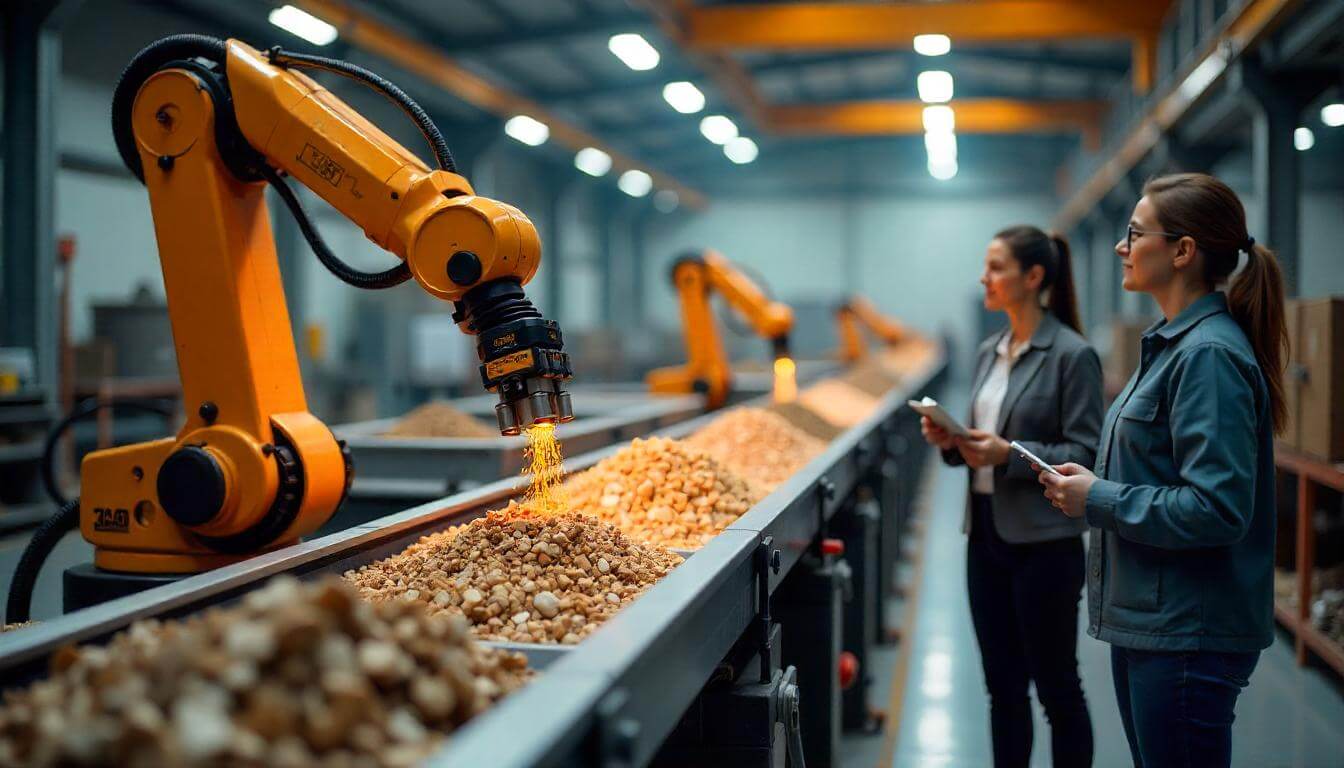The global economy has long operated on a linear model: “take, make, and waste.” This unsustainable approach depletes resources and generates massive environmental pollution. Yet, a fundamental shift is underway. The circular economy (CE) aims to decouple economic growth from resource consumption. It focuses instead on regenerating nature and eliminating waste by design. A recent $50 million green tech deal provides a powerful catalyst for this transformation. This significant investment is leveraging innovative technology to accelerate the transition to a circular model, fundamentally altering how industries manage materials and resources. This article examines a crucial financial transaction (over $50 million) that is powering the future of sustainable development.
The Imperative for Circularity: Escaping the Linear Trap
Our current economic system relies heavily on extracting finite resources. This leads to a continuous cycle of production and disposal. Consequently, we face accelerating environmental crises, including climate change and biodiversity loss. The linear model is not only environmentally damaging; it is also economically inefficient. Valuable materials are simply discarded. This approach fails to recognize the inherent value of products after their initial use.
A circular economy, by contrast, is restorative and regenerative by design. It aims to keep products, materials, and components in circulation for as long as possible. This approach maximizes resource efficiency. Furthermore, it creates new business opportunities in areas like reuse, repair, and recycling. Transitioning to a circular system is essential for long-term sustainability. It offers a viable pathway for addressing global challenges.
Green Technology as a Catalyst for Circular Economies
Green technology serves as the indispensable engine driving the circular economy transition. These innovations provide the tools needed to close the loops in industrial processes. They also enable the efficient management of waste. For instance, advanced sorting technologies powered by artificial intelligence dramatically improve recycling rates. This ensures high-quality materials are recovered and re-enter the supply chain.
Moreover, green tech includes sophisticated systems for waste-to-energy conversion and sustainable material production. Companies utilize technologies for efficient water purification and energy recovery. These methods reduce the environmental footprint of production processes. Ultimately, green technologies make circular models economically feasible. They transform waste into valuable resources, creating new revenue streams and fostering a more resilient economy.
The $50 Million Green Tech Deal: A Strategic Overview
This $50 million green tech deal is supporting a company focused on circular solutions for industrial waste streams. The investment targets innovative technologies that turn hard-to-recycle materials into reusable components or valuable energy sources. This funding aims to accelerate the deployment of these technologies across multiple sectors, including manufacturing and construction. The deal, spearheaded by a coalition of environmental investors and industrial partners, underscores a commitment to practical, scalable solutions.
The capital will primarily finance the expansion of automated sorting and processing facilities. It will also support the development of novel recycling chemistries. Furthermore, it will fund research into regenerative material science. This substantial investment is expected to significantly enhance resource efficiency. It promises to divert thousands of tons of waste from landfills annually. It therefore represents a pivotal moment in the drive towards a functional circular economy.
Innovations in Waste Management and Resource Recovery
A core component of this green tech deal involves groundbreaking advancements in waste management. Traditional recycling methods often struggle with complex materials. They also contend with mixed waste streams. However, this investment supports technologies that utilize advanced sensors and robotics. These tools identify and separate materials with unprecedented accuracy. This leads to higher purity rates for recovered materials. This purity is crucial for high-value manufacturing.
Furthermore, the deal focuses on converting organic waste into energy or nutrient-rich compost. This eliminates landfill methane emissions. It also regenerates natural systems. The company employs sophisticated bio-digestion processes. These processes capture biogas for renewable energy production. Additionally, they produce organic fertilizer. This holistic approach ensures minimal waste. It maximizes resource utilization, transforming waste from a liability into a valuable asset within the circular system.
Driving Resource Efficiency Across Industrial Sectors
This $50 million green tech deal is not confined to just waste processing; it also drives resource efficiency within industrial operations. By providing industries with tools to monitor and manage resource consumption, the technology optimizes production processes. It reduces energy use and minimizes water consumption. Smart manufacturing systems, for instance, use real-time data to identify inefficiencies and prevent material loss.
Companies benefit from reduced operational costs. They also improve their environmental performance. This competitive advantage encourages wider adoption of circular practices. Furthermore, the technology facilitates industrial symbiosis. This allows one company’s waste to become another company’s raw material. This collaboration strengthens regional economies. It also reduces overall resource depletion. Consequently, the investment has a compounding effect on sustainability across the industrial landscape.
Overcoming Challenges: From Linear Habits to Circular Systems
Transitioning from linear to circular systems involves significant challenges. Established business models often resist change. The initial cost of implementing new green technologies can be high. Furthermore, regulatory frameworks and market incentives are still evolving in many regions. Convincing industries to invest in long-term environmental solutions over short-term profits requires a shift in mindset.
This $50 million green tech deal helps mitigate these hurdles. It provides the necessary capital to de-risk innovative technologies. It proves their economic viability at scale. Moreover, the investment creates a showcase for successful circular business models. This encourages other companies to follow suit. By demonstrating profitability alongside environmental benefits, the deal helps overcome resistance. It accelerates the adoption of circular practices across the board.
Economic and Environmental Benefits of Circularity
The shift to a circular economy offers immense benefits. Environmentally, it significantly reduces greenhouse gas emissions. It conserves natural resources. It also minimizes pollution. These outcomes are vital for meeting global climate targets. Economically, the circular model creates new jobs in areas like recycling, refurbishment, and sustainable manufacturing. It also reduces reliance on volatile raw material markets.
A robust circular economy fosters local resilience. It strengthens supply chains. Businesses that embrace circularity often find they are more innovative and efficient. They also attract environmentally conscious customers. Therefore, the return on this green tech deal is measured not just in financial terms. It also accounts for substantial environmental and social gains. It underscores that sustainability is a pathway to economic prosperity.
The Future of Green Technology and the Circular Economy
The momentum towards circular economies is building rapidly. Future green technologies will likely be even more integrated and intelligent. Digitalization, including the Internet of Things (IoT) and blockchain, will enhance transparency in supply chains. It will also improve resource tracking. AI will continue to revolutionize recycling and predictive maintenance. This will extend product lifecycles.
This $50 million green tech deal is just one example of the necessary investment required. Continuous funding for R&D and implementation will be critical for scaling these solutions globally. As technology advances and policy frameworks mature, circular economies will become the new standard. This will lead to a cleaner, more resilient, and ultimately more sustainable future for generations to come.
Conclusion: A Transformative Investment in Sustainability
The $50 million green tech deal is a crucial milestone in the journey towards a circular economy. By funding innovative technologies that eliminate waste and optimize resource use, this investment is driving a fundamental transformation in how we produce and consume goods. It demonstrates that financial success and environmental responsibility can go hand in hand. This commitment to green technology is essential for building a sustainable future. It provides the resources needed to realize the potential of circular economies worldwide. This proactive approach ensures a healthier planet and a more resilient global system.

 The $50M Green Tech Deal: Driving Circular Economies">
The $50M Green Tech Deal: Driving Circular Economies">

Коментарі